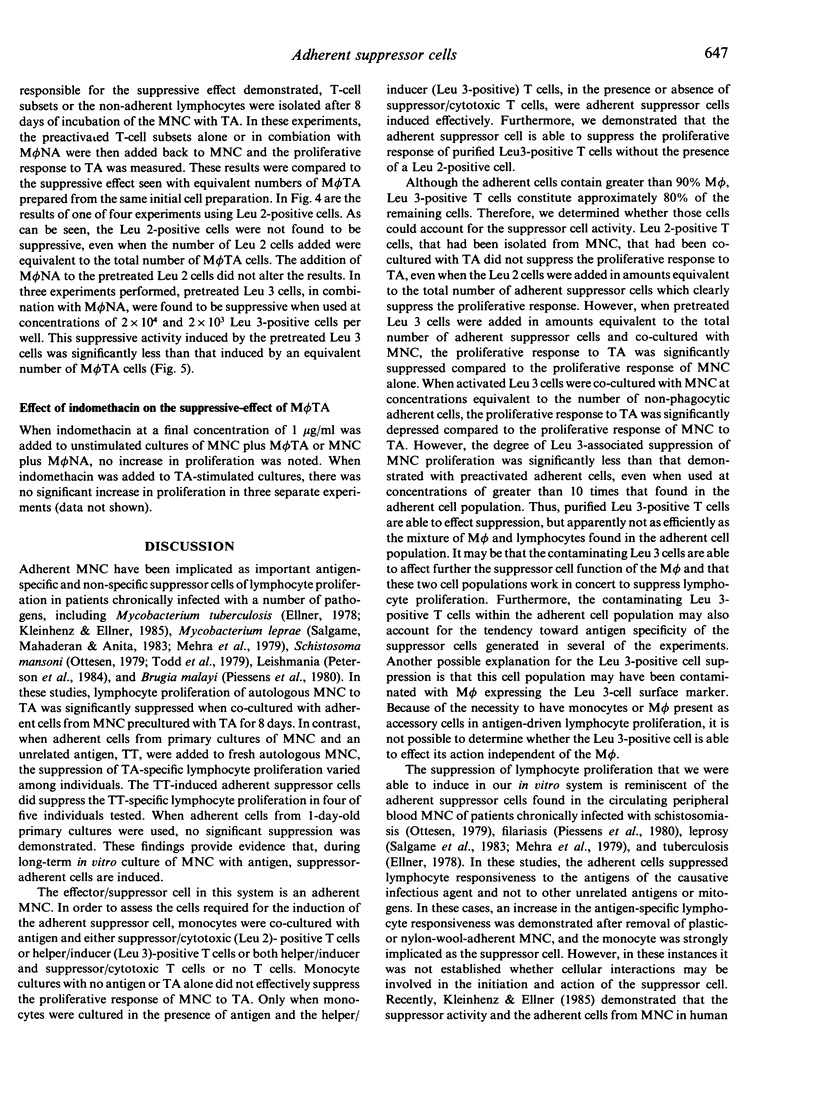Abstract
Adherent mononuclear cells have been found to suppress the lymphocyte proliferation, of T lymphocytes of patients with various chronic infections, to pathogen-specific antigens. To explore mechanisms involved in the generation of these suppressor cells, we established an in vitro method for the generation of suppressor-adherent mononuclear cells. Adherent mononuclear cells separated from mononuclear cells from subjects with serological evidence of chronic Toxoplasma infection could be induced, by preincubation with Toxoplasma antigen for 8 days, to suppress the proliferative response to autologous mononuclear cells to Toxoplasma antigen (TA) (mean suppression = 47%) and tetanus toxoid (TT) (mean suppression = 39%) compared to the proliferative response of autologous mononuclear cells co-cultured with no antigen. When adherent cells were removed after 1-day culture there was no significant suppression of the lympho-proliferative response to TA or TT. Induction of the adherent suppressor cell depended on the presence of CD4-positive T cells and not CD8-positive T cells. Adherent suppressor cells acted directly on the proliferative response of CD4 cells to antigen. The adherent cells contained 90 +/- 5% esterase-positive cells. In cell-mixing experiments, equal numbers of CD8-positive T cells pretreated in a similar manner did not have a suppressive effect. However, pretreated CD4-positive cells did have a suppressive effect at higher concentrations of cells than found in the adherent cells. Indomethacin did not alter the suppressive effect. These studies demonstrate the induction of adherent suppressor cells in vitro and implicate the macrophage and CD4-positive T cells as the suppressor cells.
Full text
PDF





Selected References
These references are in PubMed. This may not be the complete list of references from this article.
- Ellner J. J. Suppressor adherent cells in human tuberculosis. J Immunol. 1978 Dec;121(6):2573–2579. [PubMed] [Google Scholar]
- Gatenby P. A., Kotzin B. L., Engleman E. G. Induction of immunoglobulin secreting cells in the human autologous mixed leukocyte reaction: regulation by helper and suppressor lymphocyte subsets defined with monoclonal antibodies. J Immunol. 1981 Nov;127(5):2130–2135. [PubMed] [Google Scholar]
- Kleinhenz M. E., Ellner J. J. Immunoregulatory adherent cells in human tuberculosis: radiation-sensitive antigen-specific suppression by monocytes. J Infect Dis. 1985 Jul;152(1):171–176. doi: 10.1093/infdis/152.1.171. [DOI] [PubMed] [Google Scholar]
- Luft B. J., Kansas G., Engleman E. G., Remington J. S. Functional and quantitative alterations in T lymphocyte subpopulations in acute toxoplasmosis. J Infect Dis. 1984 Nov;150(5):761–767. doi: 10.1093/infdis/150.5.761. [DOI] [PubMed] [Google Scholar]
- Luft B. J., Pedrotti P. W., Engleman E. G., Remington J. S. Induction of antigen-specific suppressor T cells during acute infection with Toxoplasma gondii. J Infect Dis. 1987 May;155(5):1033–1037. doi: 10.1093/infdis/155.5.1033. [DOI] [PubMed] [Google Scholar]
- Mehra V., Mason L. H., Fields J. P., Bloom B. R. Lepromin-induced suppressor cells in patients with leprosy. J Immunol. 1979 Oct;123(4):1813–1817. [PubMed] [Google Scholar]
- Ottesen E. A. Modulation of the host response in human schistosomiasis. I. Adherent suppressor cells that inhibit lymphocyte proliferative responses to parasite antigens. J Immunol. 1979 Oct;123(4):1639–1644. [PubMed] [Google Scholar]
- Petersen E. A., Neva F. A., Barral A., Correa-Coronas R., Bogaert-Diaz H., Martinez D., Ward F. E. Monocyte suppression of antigen-specific lymphocyte responses in diffuse cutaneous leishmaniasis patients from the Dominican Republic. J Immunol. 1984 May;132(5):2603–2606. [PubMed] [Google Scholar]
- Salgame P. R., Mahadevan P. R., Antia N. H. Mechanism of immunosuppression in leprosy: presence of suppressor factor(s) from macrophages of lepromatous patients. Infect Immun. 1983 Jun;40(3):1119–1126. doi: 10.1128/iai.40.3.1119-1126.1983. [DOI] [PMC free article] [PubMed] [Google Scholar]
- Stobo J. D. Immunosuppression in man: suppression by macrophages can be mediated by interactions with regulatory T cells. J Immunol. 1977 Sep;119(3):918–924. [PubMed] [Google Scholar]
- Suzuki Y., Kobayashi A. Macrophage-mediated suppression of immune responses in Toxoplasma-infected mice. II. Both H-2-linked and -nonlinked control of induction of suppressor macrophages. Cell Immunol. 1985 Apr 1;91(2):375–384. doi: 10.1016/0008-8749(85)90235-7. [DOI] [PubMed] [Google Scholar]
- Todd C. W., Goodgame R. W., Colley D. G. Immune responses during human schistosomiasis mansoni. V. Suppression of schistosome antigen-specific lymphocyte blastogenesis by adherent/phagocytic cells. J Immunol. 1979 Apr;122(4):1440–1446. [PubMed] [Google Scholar]
- Wilson C. B., Desmonts G., Couvreur J., Remington J. S. Lymphocyte transformation in the diagnosis of congenital toxoplasma infection. N Engl J Med. 1980 Apr 3;302(14):785–788. doi: 10.1056/NEJM198004033021406. [DOI] [PubMed] [Google Scholar]


